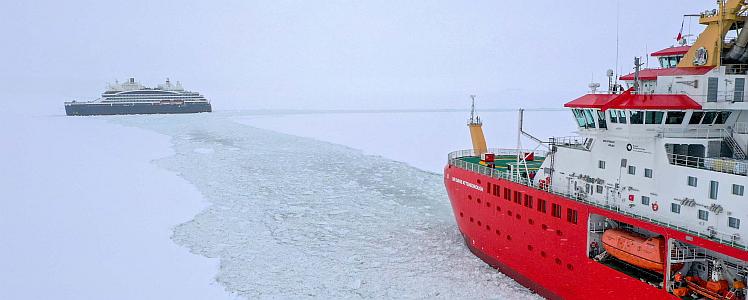 Britain’s new polar expedition ship, the RRS Sir David Attenborough, encountered particularly difficult sea ice conditions during a resupply mission as part of the research ship’s first polar expedition. It was assisted in its attempt to deliver the supplies to support the International Thwaites Glacier Collaboration, by a new and distinctive expedition cruise ship, Le Commandant Charcot, operated by the French cruise company Compagnie du Ponant.
Britain’s new polar expedition ship, the RRS Sir David Attenborough, encountered particularly difficult sea ice conditions during a resupply mission as part of the research ship’s first polar expedition. It was assisted in its attempt to deliver the supplies to support the International Thwaites Glacier Collaboration, by a new and distinctive expedition cruise ship, Le Commandant Charcot, operated by the French cruise company Compagnie du Ponant.
RRS Sir David Attenborough is capable of breaking through 1-meter thick ice at a speed of three knots. It is a Polar Class 5 vessel, classed as “ice-capable” but not an icebreaker. Le Commandant Charcot is an LNG-fueled electric hybrid icebreaker cruise ship; the first PC2 Polar Class cruise ship with the ability to break through ice up to 2.5-meter thick at a speed of three knots.
Maritime Executive reports that the expedition cruise ship was in the area of Carroll Inlet operating in the same area as the research vessel. The RRS Sir David Attenborough at the time was seeking a path to reach the British research station and deliver the scientific equipment.
“When we realized we had the opportunity to work together to support the RRS Sir David Attenborough, we immediately set off,” explains Captain Patrick Marchesseau onboard Le Commandant Charcot. “Additionally, it was a unique opportunity for our guests to see first-hand the challenges involved in polar science.”
According to Ponant, the Le Commandant Charcot’s PC2 hull design has the ability to sail in “double-acting mode” enabling the ship to tackle thicker and more dense ice. She does this more quickly and efficiently by sailing backward.
The Le Commandant Charcot sailing backward, opened a channel with the RRS Sir David Attenborough following working to widen the channel. The collaboration enabled a three-nautical mile channel to be opened in just three hours.
Unfortunately, the sea ice conditions to the drop-off point were even more unfavorable. After some deliberation, it was decided that the RRS Sir David Attenborough should turn around. They are now seeking an alternate drop-off location approximately 150 nautical miles further round the English Coast in Antarctica.
“This joint exercise highlights the value and importance of collaboration and cooperation in Antarctica, where conditions are often changeable and demanding,” said Dave Wattam, Head of Polar Operations at British Antarctic Survey. “The sea ice conditions around the English Coast are extremely challenging this year, and it’s great to work with the Le Commandant Charcot to remain on schedule.”
In addition to being a Polar Class 2 rated icebreaking vessel, Le Commandant Charcot is propelled by a hybrid diesel-electric power plant fueled by liquefied natural gas (LNG) and 5 MWh electric batteries, capable of briefly driving the ship without engines running. The ship, delivered in 2021, has a crew of 187 and a capacity of 270 passengers in 135 cabins.

Bateauie d’bateauvisage ?
Let me read this post again!! This is an absolute disgrace by the operators of the British ship.
Part of my sea-going career was as an Ice Pilot qualified Watchofficer in an icebreaker on Arctic service. Am I to understand that this “ice-classed and capable” British expedition vessel could not handle the ice conditions but a French passenger vessel could?
Good Watch.